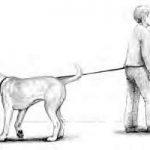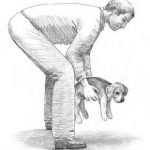Bugged In and Bugged Out: Internal and External Parasites

In This Chapter
- Tackling your blood-sucking parasite problem
- Recognizing the signs and symptoms of internal parasites
Gee whiz. How can I make this chapter fun and entertaining? It’s a difficult task, considering that I’m completely bug phobic. Thinking about any bug — flea, worm, tick, or otherwise — nesting on or in my dog really gives me the creeps.
You’re Buggin’ Me: Understanding External Parasites
Fleas
Puppy hot spotsDogs can be allergic to flea saliva, a condition veterinarians call flea allergy dermatitis. The itching from this condition is so intense that it can lead to hair loss and self-mutilation. Sometimes the itching gets so bad that your dog creates a hot spot (officially known as acute pyoderma, which is not due to a single underlying cause), and a bacterial infection develops. Go to the doctor immediately and treat the problem before the condition gets any worse. If your puppy gets one, you’ll recognize it right away: A hot spot is a bright-red, hairless patch that looks scaly, and it may ooze pus if badly infected. It’s also painful and hot to the touch. |
Tip
One surefire way to detect a problem is to buy a flea comb and brush your dog’s rear with it. If you pull out some “dirt,” put it on a paper towel and add a few drops of water. If the dirt turns a reddish color, you’re holding flea excrement. Oh joy.
Treating your puppy
Warning!
Don’t spray, rub, or squeeze flea prevention products near your dog’s face or bottom regions, because most products are toxic. Not all products are created equal. Pet stores sell many flea and tick preventions that aren’t as safe as some of the newer products. The flea product’s active ingredient and its mode of action are the most important things to know. Talk to your veterinarian first to discuss safe treatments.
Tip
Ask your vet about flea tablets or preventative powder. Although these remedies don’t take care of the fleas you have now, they do sterilize the fleas, putting a cramp in their reproductive cycles.
Treating your home and yard
– Ask your veterinarian for advice. He will likely recommend two treatments repeated in ten days to two weeks in order to kill the pupae that have turned into adults. No flea treatment can kill flea pupae.
Tip
Talk about the pros and cons of different products. Select a product that treats all life stages and repeat the treatment as suggested. Don’t forget to check the flea product label to ensure that it’s EPA approved. Follow the label instructions for personal safety.
– Vacuum, vacuum, vacuum. Not only do you pick up the adults, but you also scoop the eggs and larvae from their nests. Make sure you toss the bag after you vacuum, though — adult fleas are wonderful acrobats and may escape from the bag.
– Treat your dog’s bedding by washing it with an anti-flea detergent from the pet store or by simply throwing it out.
– Treat all rooms in your house with the recommended product and don’t forget to vacuum (but don’t suck up all the product you just applied — vacuum first). Fleas love to travel.
– Open all windows when you get home.
– Exterminate fleas in the yard. A good freeze usually takes care of them, but if you can’t wait — or if you have mild winters — talk to your veterinarian about your options. Your entire yard should be treated (it can get costly if you own a large parcel), and your dog should be kept from surrounding environments that may be infested.
Ticks
Technical Stuff
Ticks, like fleas, develop in stages: egg, larva, nymph, and adult. The eggs are laid in a damp, shady environment, and as ticks develop from stage to stage, they have several hosts and can pick up bacterial infections from any one of them.
Removing a tick
1. Stun the tick for 30 seconds with a cotton ball soaked in mineral oil.
2. With special tick-removing tweezers you can buy from a pet store, press down on the skin on either side of the tick.
3. Squeeze the skin surrounding the tick tightly and grasp the head.
4. Lift up and out.
Warning!
This step can be painful, so you may want to give your puppy a spoonful of peanut butter or some biscuits while you take care of the removal business.
5. Dispose of the tick.
Tip
It’s hard to kill these (blood) suckers. They’re drown-proof, squish-proof, and squeeze-proof. I find the best way to kill ticks is to burn them or drop them into a jar of bleach, rubbing alcohol, or vodka (for lower toxicity). If you have children, keep the jar out of their reach.
6. Wash your hands when you’re done.
Deterring ticks in the first place
– Walk your puppy in the open sunshine. Walking in the sunshine is safer because most ticks prefer to hang out in shaded, woody areas instead.
– Inspect yourself and your puppy during and after every walk in the woods or a field. If you’re with a human partner, take turns looking each other over from head to toe. If traveling alone, bring a mirror. Ticks can latch on at any level — they fall from trees, attach to the undergrowth, and crawl on the ground. (How delightful!)
To check your puppy’s coat, run a flea comb (which you can purchase at any pet store) over her coat after every outing. Ticks take awhile to burrow, so a flea comb usually picks them up.
– Wear protective clothing. To protect yourself, wear light colors and tuck your pant legs into your socks. To protect your head, wear a cap.
– Speak to your veterinarian about recommending a good topical treatment to prevent ticks. Many products on the market are less toxic and highly effective tick repellants. With topical spot treatments, you put a drop of the product on the puppy’s skin; the repellent moves through the pup’s oil glands and hair follicles to cover the whole body.
If you prefer a spray repellent to a topical one, remember not to spray repellent around your puppy’s eyes. To treat her forehead and ears, place the product onto a glove and massage into those hard-to-reach areas. Don’t forget her paws.
Warning!
Tick products are toxic. To prevent your puppy from licking herself after treatment, keep her occupied with her favorite game until the product dries. Discuss safe treatments with your veterinarian.
The quick scoop on tick diseases Because ticks feast on blood from birds and others on up through the food chain, they often carry diseases. Here are the four most common: Rocky Mountain spotted fever: Ticks carrying this disease (Dermacentor ticks) are most common in the southeast United States. However, Rocky Mountain spotted fever has been diagnosed as far north as Long Island, New York. It causes failure of blood-clotting mechanisms, rash, fever, loose and bloody stools, bloody urine, nosebleeds, and respiratory difficulty. Canine ehrlichiosis: This nasty condition is transmitted by a brown dog tick (although deer ticks are also in question). Canine ehrlichiosis causes severe anemia, fever, bruises, and bleeding disorders by attacking the white blood cells. Canine babesiosis: This disease is more common in Europe than in the United States, though the number of cases in the Gulf states is growing. This organism attacks the red blood cells, causing severe anemia. Lyme disease (canine borreliosis): Lyme disease has spread to over 47 states. It can affect most mammals and is transmitted through the common deer tick. (Nearly 50 percent of all adult deer ticks carry the disease.) After the disease gets into your dog’s system (or yours, for that matter), it seeks out joints, causing painful inflammation, fever, loss of appetite, and lameness. Left untreated, your dog’s kidneys, heart, and neurological processes may be in danger. Your veterinarian can run a titer, which measures levels of antibodies or immunity, to determine whether your dog has been infected with any of these diseases and needs treatment. |
Mites and mange
Ear mites
Remember
You can check for ear mites by examining your dog’s ear canal. If the canal is filled with brown wax and is crusty around the edge, take your pup to the vet. Your veterinarian can determine whether it’s mites or another sort of infection and can quickly get your pup on the road to recovery. After your puppy gets a professional flushing from her doctor, you need to follow up with daily drops and cleaning procedures. (Check with your vet — some newer products need only one or two applications a month apart.)
Mange mites
– Cheyletiella or “walking dandruff”: These critters hang out along your puppy’s spine and create a lot of flaking as they munch the skin. The surest sign is intense scratching and nibble-biting along the spine.
– Demodectic mange: Demodex mites are usually transferred from a mother dog to her pups during nursing. Under normal conditions, these mites exist at a harmonious level. However, if a puppy gets stressed or is malnourished, they can multiply and create either a localized infection (the infected area loses hair and becomes itchy, red, and bald) or a widespread infection (creating large, inflamed, bald patches).
– Sarcoptic mange: Otherwise known as scabies, these crab-shaped bugs burrow into your puppy’s skin and tunnel around laying eggs and sipping blood. Their favorite spots are the head region, legs, and underside. The surest sign is a dog who literally can’t stop itching all over.
Remember
As much as you want to control your pup’s itch with anti-inflammatories, don’t. Anti-inflammatory drugs, such as cortisone, lower an already weak immune system.
Below the Surface: Internal Parasites
Warning!
If you have young children, take extra precaution with the internal parasites. Some of these parasites can be transmitted to humans. Walk your puppy in an area where your children don’t play and carry a poop bag for immediate cleanup. Enforce good hygiene habits with your children, too, encouraging them to wash their hands before they eat.
Heartworms
Remember
Follow your veterinarian’s prescription. If he says to use the heartworm prevention year-round, you should do so. Also, you must still have an annual heartworm test done on your puppy because prevention doesn’t work 100 percent of the time.
Other internal critters
– Coccidia lay their eggs in stools, and dogs become infected by eating other dogs’ stools. Intestines playing hotel to these creatures become inflamed, which leads to loose, watery stools; bloating; vomiting; weight loss; and strained elimination. Diagnosis and treatment is easy when the puppy’s mildly affected and the stool checked shows coccidian eggs; however, this isn’t always the case. If you suspect an imbalance in your puppy’s system, you may need to have her stool checked more than once because the adult parasite isn’t recognizable under the microscope. If the puppy has an extreme case, the procedure to eliminate the invader can be detailed and costly.
– Giardia are water-loving creatures found in most outdoor water sources, especially in warm climates. After being ingested, they feast on the inner lining of the small intestine, creating inflammation, which leads to loose, mucus-coated stools, bloating, and weight loss. These parasites are easy to detect, but early prognosis is key.
– Hookworms not only feed off your dog’s food but also suck her blood. Dogs pick up hookworms by eating an infected animal’s feces. A pup can become infected by nursing on her mom or coming in contact with worms that creep through her tender skin. Symptoms include bloating; excessive gas; smelly, loose stools; a skinny dog with a large appetite; bloody stools; a dry, brittle coat; and even severe anemia and death.
– Roundworms float inside a dog’s body — in the liver, through the heart, and into the lungs. In their final stage, roundworms settle in the small intestine, where they feast on your dog’s dinner. Many dogs who have a case of roundworms are plagued with an insatiable appetite or no appetite and vomiting, smelly diarrhea, gas, and bloating. Often, dogs with roundworms have a very pot-bellied appearance. Make an appointment with your vet if you suspect your dog has roundworms.
Technical Stuff
Puppies are infected with roundworms in utero or from nursing on an infected mom. Older dogs can become infected by ingesting roundworm eggs, which are shed in another dog’s stool and contaminate the environment, often surviving for years. Lovely.
– Tapeworms leave evidence when they inhabit your pooch. I remember once asking my brother why a piece of rice was crawling out my dog’s rear end. Turns out it wasn’t rice after all. It was a tapeworm. Yuck. Truth is, most people discover their dog is infected with tapeworms by using the “white rice” diagnosis. Other subtle signs include an increased appetite accompanied with weight loss, rectal itching, abdominal pain, and indigestion. Dogs pick up this parasite by eating fleas, which serve as the tapeworms’ intermediate hosts. See your vet if you, too, find “rice” in your puppy’s bedding or around her potty spot.
– Whipworms live and reproduce in a dog’s large intestine, causing inflammation and the following symptoms: bloating and cramps; bloody or mucus-coated stools; a dry, brittle coat; smelly diarrhea; and a major appetite. Also, some puppies may have vomiting, anemia, and/or no appetite. Dogs become infected with whipworms by eating worm-ridden stools (an especially popular activity among pups!) or by stepping in feces and licking their paws.
Warning!
Hookworms and roundworms aren’t strangers to humans. Children can fall victim to these parasites if their play area is frequented by free-ranging pets (cats as well as dogs). These parasites are usually transmitted in a fecal-oral fashion, but they can also enter through the skin. Plus, it’s not unheard of for a responsible owner to forget to wash his hands after cleaning up after his dog or for a child to play with dog poop. If you suspect you or a child has hookworms or roundworms, call your doctor immediately. To prevent these problems, clean up after your puppy, wash your hands after cleaning, and check your child’s play area twice a day. Have your pet routinely screened for intestinal parasites, and use monthly heartworm prevention that includes intestinal parasite control. Though not common, a roundworm infection in humans can cause blindness or neurological damage.
Sarah Hodgson

































